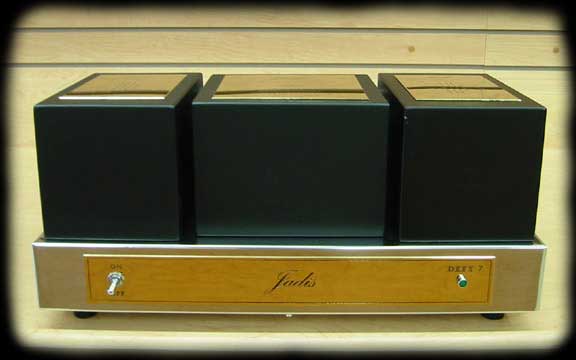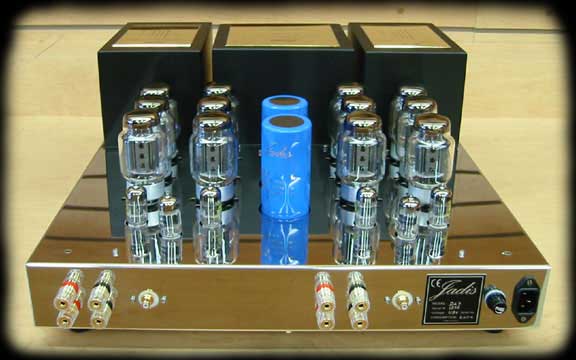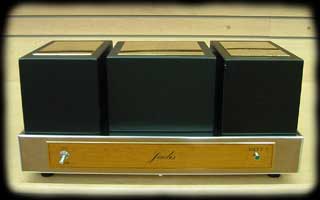Jadis DA-7 Luxe 100W Stereo Tube Amplifier Part I March, 2005 Jason Victor Serinus
|
|
|
Specifications: ● Power: 2x100 Watts at 1 kHz ● Tube Compliment: 2 x ECC82/12AU7, 4 x ECC83/12AX7/7025, 12 x EL34 or 6550 or KT90 or KT88 ● Inputs: Unbalanced RCA ● MFR: 15 Hz - 100 kHz - 3 dB ● THD: 0.06% ● Input Impedance: 100 kOhms ● Input Sensitivity: 750 mw ● Dimensions: 10" H x 20.2" W x 23.5" D ● Weight: 115 Pounds ● MSRP: $10,995 USA
Jadis
US Distributor: Pierre Gabriel Acoustics, Inc. |
Introduction
For the last 18 months, until the Jadis DA-7 Luxe came into my life, my
reference amplifier was its predecessor, the Jadis Defy 7 (pronounced,
according to French-Canadian Jadis distributor Pierre Gabriel, zha'-dis deh-fee'
set). My particular used model, a Defy 7 Mk. II manufactured ca. 1993,
arrived by way of Harry Pearson's former assistant, Scot Markwell. Keenly
aware of my sonic preferences, familiarity with live music, living situation
constraints, and bank account, I considered the amplifier a near-ideal
match and a bargain to boot.
Initially extolled in the audiophile press by the inimitable Jonathan Scull,
the Defy 7 possessed one of the most impressive midranges around. The
sound was warm, full, and musical to the core. Thanks at least partially to its hefty power
transformer, which grew even larger with the Mk. III, it also had excellent
bass. If the unit's overly dominant midrange, to some extent a product of
the Svetlana C 6550 power tubes everyone recommended for it, was not
balanced by ultimate high-end extension, the amps' sonic signature was
intentional. Jadis had designed the amp to sound good with a variety of
sources, including the lower resolution CD players of the late 1980s and early
1990s.
After going through four design iterations, the highest being the Mk. IV,
the Defy 7 morphed into the DA-7 Luxe in 2004. This a considerably different
amplifier from the original product, with a different circuit board,
different capacitors and resistors, and a larger center power transformer
that matches the size of the two flanking output transformers. Even the gold
plate on the front of the amp has been upgraded to match the look of the
other units in the Jadis line. The DA-7 also offers the first opportunity to
use KT-88 tubes with the amp.
Originally distributed by Fanfare International and then Northstar Leading
the Way, the Defy 7 was without a U.S. distributor for far too many years. Finally,
toward the end of 2004, longtime Jadis expert Pierre Gabriel of Québec
gained the rights to U.S. distribution.
Within one month of learning that Jadis was returning to the U.S., I was on
the phone with Pierre. We finally met face-to-face at CES 2005, a month
before the DA-7 Luxe arrived at my doorstep for review. It has since
replaced the Defy 7 Mk. II as my reference amplifier.

The Design
The DA-7 Luxe only accepts single-ended (RCA-terminated) interconnects, and
offers two sets of speaker outputs per channel. While one can always place a
single-ended adapter on balanced cables, my experience is that even the most
expensive XLR to single-ended adapters, manufactured by Purist, compromise
sound quality. If your preamp of choice only has balanced outputs, this may
not be the best amplifier for you.
The 100W Class A/B push-pull DA-7 uses power transformers and output
transformers handmade by Jadis in France. Twenty-one years of development
went into the design of the output transformer.
While the amp is very heavy, it consumes much less juice (approx. 240W) and
runs considerably cooler than comparable 100W Class A stereo amplifiers.
Regardless of the supposed superiority of pure Class A electronics, the
reality is that a 100W pure Class A stereo amplifier can consume upwards of
400W at idle and run extremely hot.
In my former living situation - a top 3rd floor apartment in which I kept
windows shut so that my music would not disturb the neighbors - I found 100W
of pure Class A amplification unbearable in the warmer months. Even when
sitting naked in the living room - I am not exaggerating - there was a
period of several weeks during which my amp raised the temperature into the
high 80s, making extended listening impossible. Throughout the two warmest
months of summer, I could only listen early in the day while wearing next to
nothing. Neither I nor the hanging plants wanted to spend a second summer
with that amp.
In marked contrast, I have found the cooler Jadis Defy 7 and its DA-7 Luxe
successor a breath of fresh air in more ways than one. Even with 12 power
tubes, it puts out much less heat than my former Bruce Moore 100W Dual Mono
amp and consumes less than half the current. It also sounds considerably
better.

Tube Choices
The DA-7 can accommodate a wide range of power tubes. You can choose KT-88,
EL-34, 6550, 6CA7, and KT-90 power tubes from a variety of manufacturers
depending upon personal preference.
Pierre Gabriel prefers KT-88 tubes custom manufactured for Jadis by JJ.
These are not merely JJ's standard KT-88 tubes that cost more because they
carry the Jadis logo; rather, they were specifically designed for the DA-7,
and took two years to develop. These tubes, which I use in my DA-7, cost
double the price of the Electro-Harmonix KT-88s I used in my old Bruce Moore
Dual mono amp.
Pierre likens the sound of Jadis' KT-88s to a mixture of the sound of three
other tubes.
“They have the natural sound of the 34, the punch of the 6550, and the speed
and high frequency of the KT-90,” he claims. “The Jadis KT-88 combines the
best of each tube.”
The amp also comes equipped with two Electro-Harmonix ECC 82s for the input
stage and four Electro-Harmonix ECC 83s for the transmission stage. Although
E-H Russian tubes are readily available, they are neither the tubes for
which the amp was initially designed, nor the best choice one can make.
After spending several months experimenting with different input and
transmission stage tubes, I can state without equivocation that until you
find the right combination of ECC 82s and ECC 83s to complement your choice
of power tubes, you will have only a partial idea of how good the DA-7 Luxe
can sound.
I initially approached tubing the DA-7 with the same strategy I employed
with the Defy 7 Mk. II. I kept the four stock E-H ECC 83 transmission tubes
in place, and changed the two E-H ECC 82 input tubes to the German NOS (New
Old Stock) RFTs supplied with the Mk. II by Scot Markwell. The sound gained
enormous body, so enormous that the midrange seemed overemphasized and
exaggerated. In addition the sound was overly sweet, even syrupy, and
monotonous to boot. What works well with the Defy 7 Mk. II equipped with 12
Svetlana C 6550 power tubes does not necessarily sound good in a DA-7 Luxe
equipped with Jadis KT-88s.
Following Pierre's counsel, I have since learned that the choice of ECC 83s is
as important as the choice of ECC 82s. You need to change all six tubes if you
want this amp to sound like a million bucks.
I confess that I have neither the time nor resources to conduct an
exhaustive audition of NOS tubes. A month of tube rolling, which consumed so
much time that I am way behind in my reviews, was enough. But auditioning
NOS RFTs, RCA ECC82 equivalents, Telefunken ECC 82s, and JAN Philips 5814As
leads me to choose the latter (Pierre's recommended input stage tube) by a
long shot.
The same goes for Pierre's choice of ECC 83s for the transmission stage. I
initially mistook his recommendation of four GE 5751 JANs to mean four JAN
Philips 5751s. Not a good move. Paired with the JAN Philips 5814 input
tubes, JAN Philips 5751s were not a good transmission tube match for the
Jadis KT-88s.
After I put out a call to my fellow audiophiles for reliable tube sources,
Ori Mizrahi-Shalom of the Bay Area Audiophile Society (manufacturer of the
just released Oritek interconnects I have yet to audition) offered me four
NOS GE 5-Star 5751s. Again, I mistakenly thought that these were the tubes
that Pierre recommends.
What did I hear? Tons of air, tons and tons of air, in fact an artificial
preponderance of air with the image set very far back in the soundstage.
Great bass extension, a large amount of lower bass information (albeit
somewhat muffled and distorted), and a lack of brilliance on high rendered
the tubes fascinating to listen to but less than ideal.
Next, Oakland's incredible fount of audio and jazz information known as
David Tonelli informed me that while ECC 83, 12AX7, and 7025 tubes all have
a gain of 100, 5751 tubes have a gain of 70. Perhaps, I thought, the lower
gain of the GE 5 Star 5751s was the source of my dissatisfaction.
David then went
to his stash of NOS tubes and, much to our mutual surprise,
pulled out four never played GE 5-Star 7025s. These, I was certain, would
bring me the sound I desired.
Not quite. If the GE 5751s emphasized the midrange and below to the
exclusion of high frequency extension, the GE 7025s favored highs over
everything else. They were lovely sounding on top - warm, sweet, lush and
far more forward than their sisters. But where were the lower midrange, bass,
and air to balance their highs out? Pretty non-existent, as far as I could
tell, at least when mated with the other tubes in the amp.
After weeks of experimentation, I arrived at the following choice of tubes:
● Two JAN Philips 5814As for the input stage
● Two GE 5-Star 5751s in the left socket in each channel (looking from the
front to the rear over the transformers) of the transmission stage
● Two GE 5-Star 7025s, one positioned to the right of each 5751, for the
remaining two transmission stage tubes
This configuration offers a decent amount of high extension, a huge amount
of air, good detail, and a warm, slightly romantic presentation. If you
reverse the order of the 5751s and 7025s, you get more bass at the expense
of high extension.
Finally, again seemingly by accident, Brian Cheney of VMPS told me about a
local retail source for NOS tubes. A visit uncovered four NOS GE 5751 JANs.
These tubes sound nothing like either the GE 5-Star 5751s or GE 5-Star
7025s. I now know why Pierre Gabriel prefers the combination of:
● Two JAN Philips 5814As for the input stage
● Four GE 5751JANs for the transmission stage
Note that there is yet a third combination of tubes worthy of audition:
● Two JAN Philips 5814As for the input stage
● Two GE 5-Star 5751s in the left socket and two GE 5751JANs in the right
socket of each channel's transmission stage
And that's of course only taking into consideration the limited number of
NOS tube choices I tried.
I have more to say about choice of input and transmission tubes in the
listening section that follows. For now, please keep in mind that the
sound of NOS tubes changes greatly after you clean corrosion off the pins.
Following David Tonelli's suggestion, I first used a thin, soft pencil
eraser refill, cylindrically shaped with a diameter small enough to push
over one tube pin at a time. I carefully pushed the eraser onto each pin,
twisted it around, removed it, and then moved on to the next pin. By the
time I had finished with the four GE 5751 JANs, both ends of the eraser were
filled with black-marked holes. Then I carefully cleaned the pins with Caig
De-Oxit, making sure not to leave excess residue behind. This greatly
affected the sound of the tubes, removing much of an objectionable edge that
turns out to have been distortion. All to the better.


